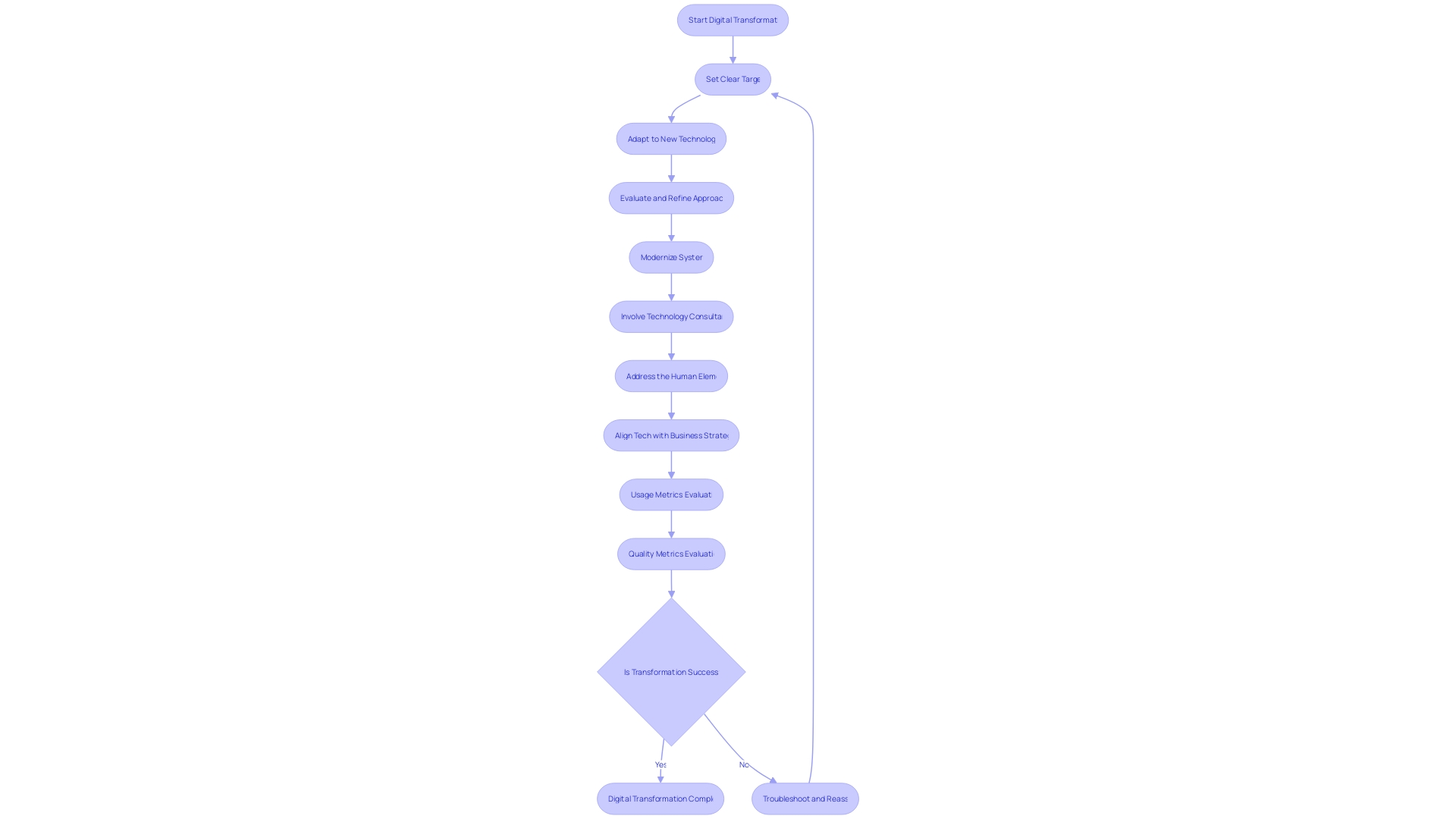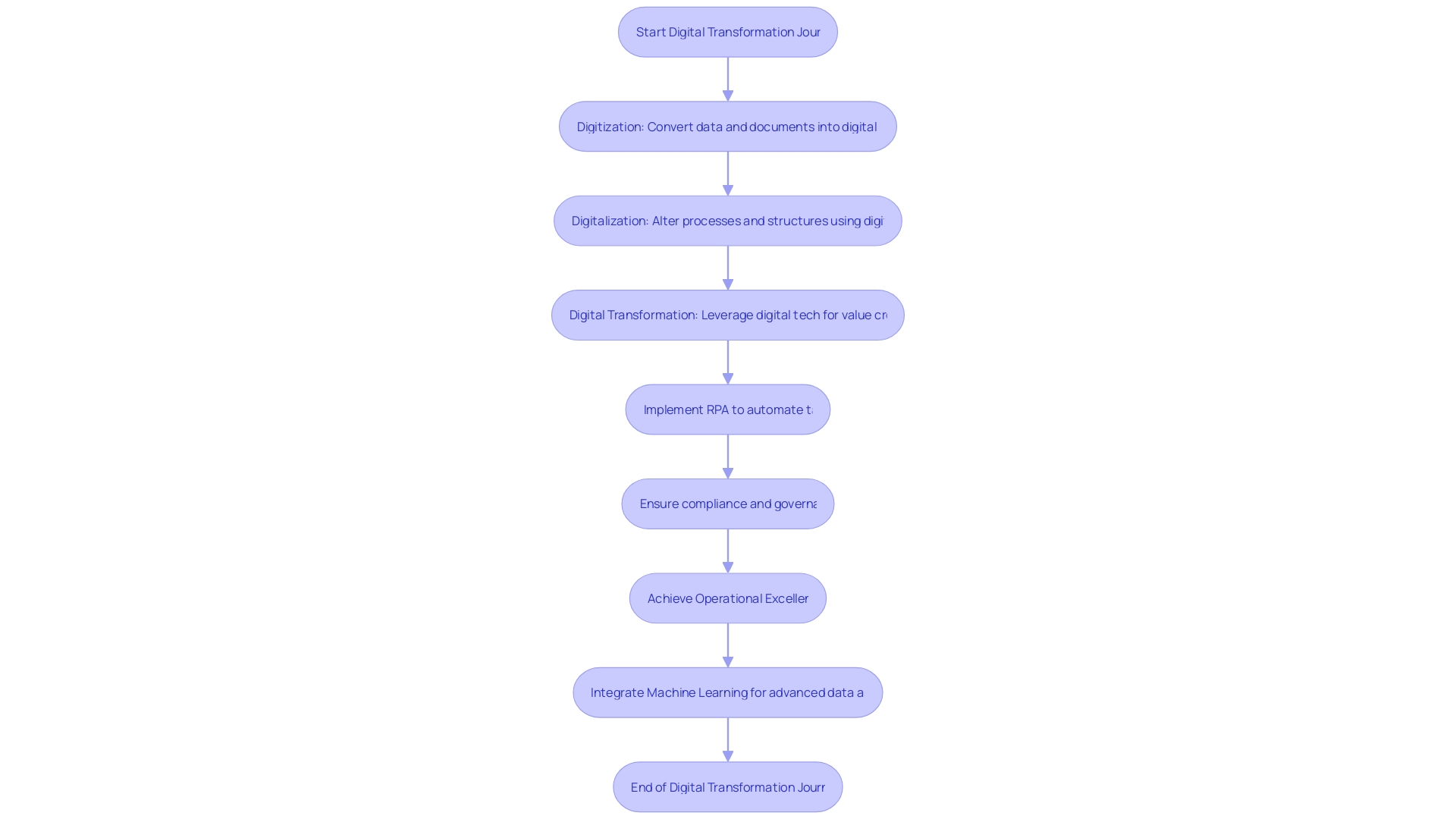Introduction
Digital transformation is a crucial journey for businesses striving to remain competitive and meet evolving customer needs. Technology consultants play a pivotal role in driving this transformation, bringing their expertise to the table and implementing innovative solutions that enhance business processes and outcomes.
However, the path to digital transformation is not without its challenges, as companies must ensure these initiatives align with productivity and efficiency goals while integrating risk management and robust security protocols. This article explores the role of technology consultants in driving digital transformation, the importance of cybersecurity and compliance, strategies for successful transformation, enhancing customer experience through digital solutions, and streamlining processes with emerging technologies. Through these insights, businesses can gain a comprehensive understanding of the key factors involved in successful digital transformation and how to harness technology effectively to maintain a competitive edge.
The Role of Technology Consultants in Driving Digital Transformation
The journey of digital transformation is essential for businesses that aim to remain competitive and meet the evolving needs of customers. A pivotal element in this journey is the expertise of technology consultants, who bring a wealth of knowledge and experience to the table. They play an instrumental role in not only identifying the potential for innovation but also in implementing solutions that significantly enhance business processes and outcomes.
For instance, consider the case of Lincoln Financial, which faced the monumental task of migrating 120 complex systems to the cloud within a two-year period. This initiative aimed to reduce operational costs, mitigate the financial burden of fixed-cost legacy platforms, and establish a more modern and flexible environment. The strategic move to shift decision-making from IT to business units, as described by Satyendra Kumar, further empowered each line of business to tailor technology spending to their specific goals.
However, digital transformation is not without its challenges. Companies must ensure these initiatives are not siloed from productivity and efficiency goals. As per insights from Accenture, Infosys, and Wipro, successful digital transformation projects are those that self-fund future investments through savings and value created via automation, process improvement, and efficiency.
Moreover, a survey revealed that 56% of US businesses are driven to digital transformation by regulatory and security concerns. This highlights the importance of integrating risk management early on, with 63% agreeing that doing so significantly increases success rates. The top risk priority for these businesses is keeping up with cybersecurity regulations, underscoring the need for robust security protocols.
Ultimately, the value of digital transformation is evident. Companies that excel in digital and AI capabilities outperform their counterparts by two to six times on total shareholder returns. This gap is widening, emphasizing the urgency for businesses to harness these technologies effectively to create sustainable value and maintain a competitive edge.
Case Study: Leveraging Emerging Technologies for Business Growth
At the heart of digital transformation lies the strategic integration of AI and IoT technologies, which can catalyze substantial enhancements across operational efficiency, cost management, and customer satisfaction. A prime example of this is the experience of a leading global manufacturing company that embarked on a digital overhaul.
By collaborating with a tech consultancy skilled in navigating digital landscapes, the company harnessed the power of AI to refine their quality control processes, leading to a notable uptick in operational visibility and analytics. This transformation was not without its challenges.
The company had to address a cultural shift, overcoming resistance to change and compliance concerns that often accompany such initiatives. Yet, the results speak for themselves: a streamlined workforce capable of maintaining robust IT infrastructure with significantly fewer resources, akin to the transformation seen at Vodafone following their cloud migration.
Moreover, the manufacturing company's venture into digital transformation mirrors the broader industry trend, where businesses are increasingly investing in cloud and AI technologies. With 62% of firms adopting cloud solutions and 55% incorporating AI, it's evident that these technologies are at the forefront of operational advancement. However, it is the effective management of these tools that distinguishes successful transformations, as seen in the 69% of companies recognizing the gap between investment and expected outcomes. In conclusion, the strategic deployment of digital technologies, underpinned by a keen understanding of the human element in IT, is not merely a matter of adopting new tools but a comprehensive reimagining of business processes to thrive in a digitally-driven economy.
Key Strategies for Successful Digital Transformation
To drive a successful digital transformation, it's imperative to set well-defined targets and to be prepared to adapt to new technologies. This process is not a one-time endeavor but an ongoing journey, requiring a company to remain agile and continuously evaluate and refine its approach.
For instance, consider the experience of an insurance company that faced substantial financial challenges with its fixed-cost legacy platforms. By modernizing 120 complex systems within an aggressive two-year timeline, the company not only reduced operating costs but also shifted decision-making power from IT to the business side, aligning spending with business goals.
Supporting this transformation, technology consultants play a vital role, bringing expertise in selecting appropriate digital tools and guiding teams through the adoption process. This addresses the human element of IT, ensuring that change is not just a technical upgrade but a natural progression that enhances the customer experience.
Despite the investments in technology, it's crucial to understand that most digital transformations fail due to non-technical issues such as resistance to change and organizational restructuring. Thus, a comprehensive plan that encompasses both technology and its adoption is key. The urgency for transformation is backed by statistics indicating that global digital transformation spending is expected to reach $3.4 trillion by 2026, with businesses acknowledging the immense value a robust digital strategy can deliver. However, capturing this value is not guaranteed, as evidenced by companies that have realized less than a third of the expected value from their digital initiatives. The gap between digital leaders and laggards is widening, highlighting the importance of not just adopting digital and AI capabilities, but doing so effectively and swiftly to outperform competitors.

The Importance of Cybersecurity and Compliance
In today's digital-centric world, companies like Applied Systems are accelerating their shift towards cloud-native solutions, driven by the need for agility, efficiency, and enhanced security. Tanner Randolph, Chief Information Security Officer at Applied, emphasizes the journey towards becoming a cloud-native company, underscoring the importance of centralizing data collection and analysis to streamline security operations.
OpenPayd echoes this sentiment, as Security Engineer Jordan Andonov points out the complexity of managing numerous platforms and the necessity for a centralized log management solution to monitor their Banking-as-a-Service platform effectively. Highlighting the critical nature of cybersecurity, recent statistics are startling: cybercrimes, particularly ransomware attacks, surged by 102 percent in early 2021.
Notably, more than 75 percent of these crimes initiate with a malicious email. As of 2023, it's reported that over half of large companies are investing upwards of $250 million annually in cybersecurity, and yet 91% still reported cyber incidents, with 56% facing severe consequences.
In response to these challenges, regulatory bodies are stepping up. The Securities and Exchange Commission (SEC) is introducing new disclosure requirements for cybersecurity, aiming to provide investors with more informative disclosures and thus reducing information asymmetries.
Coupled with the White House's proposed AI Bill of Rights and the FTC's focus on AI-related consumer issues, organizations are compelled to adopt strategic data architectures that offer flexibility and seamless compliance across various markets. A survey of audit committee board members in 2022 identified cybersecurity as a paramount concern for the upcoming year, a sentiment reinforced by consumer behavior. A staggering 53 percent of consumers choose companies based on their data security reputation, and 40 percent abandon services upon discovering inadequate data protection. This demonstrates the integral role of cybersecurity not only in safeguarding operations but also in building customer trust and loyalty. For businesses, the integration of robust cybersecurity measures and compliance with industry-specific regulations is not optional but a strategic imperative. Encryption, access controls, and regular vulnerability assessments are just the starting points in a landscape where trust in data security is a decisive factor in consumer decision-making.
Enhancing Customer Experience through Digital Solutions
Embracing digital transformation is not a one-size-fits-all solution; it's a multifaceted endeavor tailored to the unique needs of each business. For example, Vodafone's collaboration with Accenture and AWS streamlined their operations from a 20-person team working around-the-clock to a lean team of five, enhancing their IT infrastructure's resilience. This strategic move not only reduced costs and improved efficiency but also contributed to a staggering 250% increase in throughput and impressive customer experience accolades.
In the digital era, companies must navigate customer privacy concerns while crafting engaging experiences. A Prosper Insights & Analytics survey revealed that 57.9% of respondents worry about personal information tracking on their devices, highlighting the importance of balancing innovation with privacy. Additionally, the digital landscape offers a competitive arena where a compelling digital experience can be a company's most significant asset.
By integrating AI-augmented systems, businesses can deliver efficient and personalized customer service, as noted by Keith Kirkpatrick of The Futurum Group. This approach not only expedites problem resolution but also fosters confidence in high-value transactions. Realizing the full potential of digital transformation requires a keen understanding of the customer journey, leveraging AR and VR for immersive experiences, and optimizing digital touchpoints, such as mobile applications, to meet the increasing demand for seamless and personalized interactions.

Streamlining Processes and Automation with Emerging Technologies
In the realm of digital transformation, organizations are harnessing the power of technology to reshape their operations. Robotic Process Automation (RPA) and machine learning stand at the forefront of this revolution, enabling businesses to automate tasks that are repetitive and rule-based, such as data extraction from specific locations in a spreadsheet. The value of these technologies extends beyond mere efficiency; they offer rapid adaptability to changing business needs and regulatory environments, ensuring that organizations remain compliant and agile.
With RPA, tasks can be executed with unprecedented speed, dramatically reducing process completion times, especially for tasks that are high in volume. This acceleration is coupled with a significant reduction in errors, as automation minimizes the risk of human error, ensuring higher accuracy and less need for costly rework. However, it's crucial to understand that despite the efficiency gains, there is still a need for human oversight.
The most effective digital workers are those that are guided by human intuition and expertise, particularly when complex processes involve multiple systems and require human interaction. Embracing hyperautomation is not just about adopting new technologies; it's about continually refining processes to leverage the full potential of AI, effectively unlocking new levels of operational excellence. As industry leaders have noted, the journey towards hyperautomation is continuous, and it requires a mindset focused on perpetual improvement.
By strategically integrating modern software technology and prioritizing seamless integration, businesses can achieve greater success and deliver enhanced value to stakeholders and customers alike. This strategic imperative is echoed in the words of technology consultants who emphasize starting with the problem, not the technology, highlighting the importance of a solid data foundation to realize the potential of AI and automation. Finally, with the adoption of workflow automation solutions, research suggests a notable reduction in financial close times, underscoring the competitive advantage and time-saving benefits that come with it.

Conclusion
In conclusion, technology consultants are instrumental in driving digital transformation by leveraging their expertise to identify innovative solutions and enhance business processes. Successful transformation requires aligning initiatives with productivity goals, integrating risk management, and prioritizing robust security protocols. Cybersecurity and compliance are crucial aspects of digital transformation.
Companies must prioritize the integration of strong cybersecurity measures and ensure compliance with industry regulations to safeguard operations and build customer trust. To achieve successful digital transformation, businesses should set clear targets, remain agile, and continuously evaluate their approach. Technology consultants play a vital role in selecting appropriate digital tools and guiding teams through the adoption process while addressing the human element to enhance the customer experience.
Enhancing customer experience through digital solutions involves tailoring the transformation journey to meet specific business needs. By integrating AI-augmented systems, businesses can deliver efficient and personalized customer service while optimizing digital touchpoints for seamless interactions. Streamlining processes with emerging technologies like Robotic Process Automation (RPA) enables organizations to automate tasks, reduce errors, improve efficiency, and ensure compliance.
However, human oversight is still essential for complex processes involving multiple systems. Overall, successful digital transformation requires harnessing technology effectively to create sustainable value and maintain a competitive edge. With the guidance of technology consultants and a comprehensive understanding of factors such as cybersecurity, compliance, strategy implementation, customer experience enhancement, and process streamlining with emerging technologies, businesses can navigate the path of digital transformation successfully in today's evolving business landscape.





